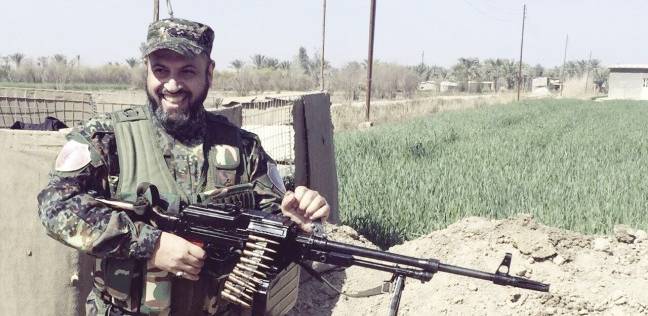
October 2015 Briefs
Publication: Militant Leadership Monitor Volume: 6 Issue: 10
By:

THE IRGC’S IRAQI POINT MEN IN SYRIA: SHAYKH AUWS AL-KHAFAJI AND SHAYKH AMMAR AL-LAMI
Nicholas A. Heras
The Liwa Abu Fadhil al-Abbas network, including its affiliated organization Quwat Abu Fadhil al-Abbas, is an important component of the Iranian Revolutionary Guard Corps (IRGC)-coordinated militias supplementing the Syrian government’s forces in many loyalist areas, including in and around the country’s capital of Damascus. [1] Shaykh Auws al-Khafaji, the Secretary General of the organization, and his primary adjutant Shaykh Ammar al-Lami (a.k.a. Abu Kamil), the commander of the organization’s special forces, are responsible for coordinating Quwat Abu Fadhil al-Abbas’ operations in Iraq and Syria (El-Watan News [Cairo], October 9; YouTube, July 16; YouTube, May 8; al-Nahar [Beirut], December 14, 2014; al-Sharq [Riyadh], May 5, 2013). Since 2012, Shaykh al-Khafaji and Shaykh al-Lami have helped coordinate Iraqi Shi’a fighters traveling from Iraq to the southern Damascus suburb of Sayyida Zaynab, especially through the Liwa Abu Fadhil al-Abbas network, to protect the important Shi’a shrine of the same name, including traveling in person to the Sayyida Zaynab neighborhood (YouTube, May 23; Mawazin News, May 10; al-Nahar [Beirut], December 14, 2014; YouTube, November 10, 2014; All4Syria [Damscus], June 20, 2014). Al-Khafaji recently reaffirmed his organization’s leading role in providing military support for the al-Assad government and its close ties to the IRGC:
However, in Iraq, both al-Khafaji and al-Lami are careful to place Quwat Abu Fadhil al-Abbas’ role in that country within a nationalist, pan-sectarian context, where the organization is portrayed as being most active under the umbrella militia network of the Popular Mobilization Committees that are coordinated by the Iraqi Ministry of Interior. They reject the assertion that Quwat Abu Fadhil al-Abbas is a Shi’a sectarian force that targets the Iraqi Sunni community and only serves the interests of the IRGC (YouTube, October 26; YouTube, July 16; YouTube, June 21; YouTube, May 8; YouTube, April 5; YouTube, March 4; YouTube, January 13). Shaykh al-Khafaji, in particular, has become a frequent commentator in Iraqi media on the anti-Islamic State military role of Quwat Abu Fadhil al-Abbas, and is a figure of increasing public stature inside Iraq as the organization improves its media outreach (YouTube). The public image that is cultivated by both Shaykh al-Khafaji and Shaykh al-Lami is that of fighting clerics, providing religious instruction and moral authority, while being portrayed as effective military strategists and warriors, leading Quwat Abu Fadhil al-Abbas fighters from the frontlines (YouTube, May 28; YouTube, May 23; BuzzFeed, April 1; YouTube, March 24; YouTube, November 14, 2014).
Shaykh Auws al-Khafaji
Shaykh al-Khafaji, 42, is a native of the large town of al-Shatrah in Iraq’s south-central Dhi Qar governorate, located 41 kilometers northeast of the governorate’s capital, al-Nasiriyah (YouTube, June 21). He asserts that he was a political activist from a young age, participating as a 17-year-old in the popular uprisings in al-Shatrah, which were similar to other uprisings against the Saddam Hussein government in Shi’a-majority areas throughout southern Iraq in 1991 (YouTube, April 5). Furthermore, al-Khafaji has extensive experience as a political activist, religious leader and militia organizer, beginning this experience with Sayyid Muqtada al-Sadr’s Jaysh al-Mahdi (Mahdi Army) organization in the mid-2000s (YouTube, May 8; YouTube, December 20, 2011). Later that decade, al-Khafaji was associated with the formation of the Promised Day Brigade in 2008, reportedly an IRGC-backed organization associated with al-Sadr that was referenced by U.S. military commanders as one of the most effective and dangerous Shi’a organizations fighting coalition forces in Iraq (al-Basrah.net [Basra], November 10, 2010; al-Jazeera, September 11, 2011; Los Angeles Times, July 14, 2010; American Forces Press Service, February 17, 2010).
Al-Khafaji studied at a university in Basra, where he began instruction in the hawza (Shi’a religious school). He eventually traveled to Najaf, during which time he became a disciple and student of Sayyid Muhammad Muhammad Sadeq al-Sadr, the father of Sayyid Muqtada al-Sadr and an extremely popular and controversial Iraqi Shi’a cleric who was assassinated by the Saddam Hussein government in February 1999 (YouTube, June 21). After completing his religious studies, al-Khafaji entered the elder al-Sadr’s service as a prayer leader in al-Nasiriyah, a position that eventually led to al-Khafaji’s arrest and imprisonment by the Saddam Hussein government in February 1999, shortly after the assassination of Sayyid Muhammad Muhammad Sadeq al-Sadr (Uruk News Agency [Baghdad], June 23; YouTube, June 21; Iraq News, February 22, 1999).
After Saddam Hussein was deposed and al-Khafaji was released from prison, he became an important adjutant to Sayyid Muqtada al-Sadr, serving in a variety of public roles: for instance, he was the Sadrist movement’s spokesman and prayer leader in al-Nasiriyah, and an interlocutor between the Jaysh al-Mahdi organization and the foreign press, officials from the U.S.-led coalition administration and coalition military forces (CNN, May 20, 2005; al-Jazeera, August 25, 2004; San Francisco Chronicle, June 26, 2004). [2] However, the relationship became strained and even confrontational when Sayyid Muqtada al-Sadr decided that Jaysh al-Mahdi would cease violent resistance against the U.S.-led coalition, and al-Khafaji refused. As a result of pressure from coalition forces, he reportedly lived in exile in the Sayyida Zaynab area of Damascus from the middle of 2006 to May 2007 (Uruk News Agency [Baghdad], June 23; YouTube, June 21; YouTube, February 18, 2012; Jawabna [Najaf], February 9, 2012; Al-Basrah.net [Basra], November 10, 2010).
While in exile, al-Khafaji built a network among the existing Iraqi communities in that Damascus neighborhood, the majority of which are comprised of Shi’a refugees. This local Damascene network would eventually be built into a force that Shaykh al-Khafaji claims currently has more than 1,500 fighters, and has participated in battles on behalf of the al-Assad government in Damascus and in the mountainous Syrian-Lebanese border region of the Qalamoun (El-Watan News [Cairo], October 9; al-Nahar [Beirut], December 14, 2014; Tariq Karbala News, May 20, 2007). Al-Khafaji’s leadership role in Quwat Abu Fadhil al-Abbas pairs well with his adjutant and mentee, Shaykh Ammar al-Lami, who is emerging as a major, albeit youthful leader in the Iraqi Shi’a political militia movement.
Shaykh Ammar al-Lami
Al-Lami, 27, is a native of the al-Karkh district of Baghdad, and he studied fiqh (Islamic jurisprudence) at a hawza in the suburb of Kadhimayn. He was influenced by the ideology of the Da’wa Party from a young age, and he also spent time in Najaf studying under important clerics in the Sadrist movement (YouTube, July 16). A teenager when the U.S.-led coalition deposed the Saddam Hussein government, he eventually joined a local Jaysh al-Mahdi affiliate in Kadhimayn, and the experience of being a young member of the resistance against the coalition forces in Iraq significantly shaped al-Lami’s worldview in support of the Shi’a Islamic Resistance, helping him develop into a young, rising leader in the local, Shi’a militia network (YouTube, July 16; YouTube, November 10, 2014). By late 2012, al-Khafaji and al-Lami were reportedly working together to send Iraqi Shi’a fighters to protect the shrine of Sayyida Zaynab, but it was the rise of the Islamic State in western Iraq after it captured the northwestern city of Mosul in June 2014—and the threat that the Salafist group posed to Shi’a areas of Iraq—that brought al-Khafaji and al-Lami formally together to build Quwat Abu Fadhil al-Abbas (El-Watan News [Cairo], October 9; YouTube, July 16; al-Nahar [Beirut], December 14, 2014).
Al-Lami reportedly maintains ties to Asa’ib Ahl al-Haq (AAH—League of the Righteous Ones), and currently serves in a coordinating role between Quwat Abu Fadhil al-Abbas and other Iraqi Shi’a organizations that are part of the PMCs, as well as groups that have long-standing ties to IRGC-backed Iraqi Shi’a militias, such as AAH (YouTube, July 16; YouTube, November 10, 2014). Helping with this position is the fact that he was previously an official with al-Muqwama al-Islamiyya fi al-Iraq-Liwa al-Wa’ad al-Sadiq (The Islamic Resistance Movement in Iraq—Legion of the Truthful Pledge), an umbrella organization of Iraqi Shi’a militias (YouTube, November 10, 2014; Baghdad International News Agency, March 8, 2012). Although a relatively young commander, al-Lami is well positioned to be an important figure in the IRGC-backed Iraqi Shi’a militia network, and he seems to be more clearly tied than al-Khafaji to the ideology of the wilayat al-faqih (state of the jurisprudence) that governs the Islamic Republic of Iran.
Conclusion
Quwat Abu Fadhil al-Abbas is an important organization within the IRGC’s predominately Iraqi Shi’a militia network, which is a primary source of reserve manpower for the al-Assad government to conduct offensive operations in Syria and to hold terrain in strategic loyalist areas, particularly in Damascus. Shaykh al-Khafaji and Shaykh al-Lami have been important organizers within this network, including in establishing its initial operations center in the Sayyida Zaynab district of Damascus. Quwat Abu Fadhil al-Abbas is also rising in prominence in Iraq, and it could be positioned to be a major military and social actor. Increasingly, Quwat Abu Fadhil al-Abbas and its IRGC network affiliates are important to the anti-Islamic State campaign for the Iraqi government in Baghdad. Guided by al-Khafaji and al-Lami’s leadership, Quwat Abu Fadhil al-Abbas is seeking to portray itself the foundation of a popular resistance force against the Islamic State and foreign actors—such as the United States, Israel and Sunni Gulf Arab countries—that it views as being hostile toward Iraq and the group’s IRGC patron.
Notes
1. For a comprehensive analysis of the strategic role that IRGC-backed Iraqi Shi’a militias play in supporting the al-Assad government and this network’s potential broader role in the Middle East region, see: Philip Smyth, The Shiite Jihad in Syria and Its Regional Effects, Washington Institute for Near East Policy, February 2015, https://www.washingtoninstitute.org/uploads/Documents/pubs/PolicyFocus138-v3.pdf. Smyth also analyzes the evolution of the Liwa Abu Fadhil al-Abbas organization, including Quwat Abu Fadhil al-Abbas, in The Shiite Jihad in Syria and Its Regional Effects.
2. In this capacity, Shaykh al-Khafaji notably was the intermediary who handled the release from captivity of the American journalist Micah Green and his Iraqi translator in August 2004, the pair having been kidnapped by Shi’a militias with ties to Jaysh al-Mahdi and held in al-Nasiriyyah before their release in late August 2004. For more information on Shaykh al-Khafaji’s role in the release of Micah Green and his Iraqi colleague, see: Micah Garen and Marie-Hélène Carlton, American Hostage: A Memoir of a Journalist Kidnapped in Iraq and the Remarkable Battle to Win His Release, (New York: Simon & Schuster, 2005), pgs. 15, 88, 215-216, 247.




